Overview
By Steve Vickers, founder of Sweden travel guide routesnorth.com
Best known for churning out heavy metal – in the form of ships, Volvos and bands such as In Flames – Gothenburg has spent the past couple of decades reinventing itself. Industry is still important, but now the west coast’s biggest city looks at ease on the pages of glossy travel magazines and is giving Stockholm a run for its money in the city-break stakes.
The container ships still chug into Gothenburg’s blustery port (the biggest in Scandinavia) but are now joined by cruise liners full of tourists – 73 of them docked in 2014, compared with just nine in 2000. This autumn, British Airways, Norwegian and Ryanair are all adding extra flights from London to Gothenburg. And in Hisingen, just across the Göta river from the city centre, a new waterfront leisure area, the Jubileumsparken, is being built to celebrate the city’s 400th anniversary, in 2021. The first section, with a free public sauna made from recycled materials, is already open, but construction work will keep going in this area until at least 2035.
And within the city the changes are huge: tumbledown shops and industrial buildings have been turned into galleries; bars selling organic ales have moved into once-rundown neighbourhoods; and the picture-perfect fishing villages that dot the coast north and south of the city have begun reeling in food critics with their fresh crayfish, lobster and prawns. Add in a blossoming local design scene, six Michelin-starred restaurants, a sprawling archipelago of low-slung granite islands, plus a new wave of cool independent coffee shops across town (the city still has only one branch of Starbucks, inside the central railway station), and it’s easy to see why visitor arrivals rose by almost 10% in 2014.
Nowhere is Gothenburg’s transformation more obvious than in the district of Haga on the south side of the Göta, once so rundown and rowdy that large parts were demolished in the 1970s, although many of the area’s old buildings have been renovated. The part left standing is now the city’s showpiece district, its cobbled lanes lined with cosy cafes selling plate-sized cinnamon buns to tourists and lattepappor (latte dads, or young fathers off work on parental leave). Locals seem to welcome the influx of visitors but, being a modest bunch, are often bemused as to why anyone would choose their city for a holiday.
The new bars and restaurants opening on Gothenburg’s grungy “long streets”, just west of Linnégatan (where Haga meets Masthugget), are increasingly swanky, specialising in everything from dim sum to tequila. Gentrification is pushing students, artists and musicians out towards neighbourhoods like Majorna, traditionally home to dockers and industrial workers, but classic watering holes such as Publik and Kelly’s keep things feeling relaxed – think Acne jeans, arm-length tattoos and scuffed white Converses, rather than Stockholm’s slicked-back style.
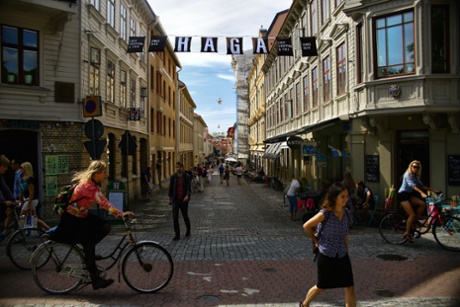
The old working-class district of Haga, once so rundown and rowdy, is now the city’s showpiece district. Photograph: Souvid Datta for the Guardian
Top-end seafood restaurants such as Sjömagasinet tend to get most of the attention in travel guides, but you can eat and drink well in Gothenburg without going overboard, or even dressing up – try the food carts that set up on Magasinsgatan and Linnégatan streets, the new waterside bar-restaurants in Rosenlund, or the cluster of individualistic street-food outlets on Skanstorget. The city’s large student population means there’s a boozy late-night crowd, especially at weekends, with DJs, skateboarders, designers and doctors-in-training all cramming into the most popular venues.
Music/clubs scene
By Björn Wurmbach, German-Swedish music promoter and festival organiser
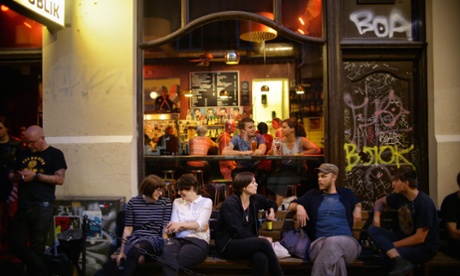
A busy evening at the popular Publik bar on Andra Långgatan. Photograph: Souvid Datta for the Guardian
I started doing parties on my 30th birthday, which we celebrated on an island in the archipelago off Gothenburg. I organised it with some friends and to start with a lot of things went wrong. Now, that island party has evolved into an exclusive festival called Secret Island Nation, which has just celebrated its 10th anniversary. Instead of complaining about the system and capitalism, we create our own nation, which is ours for four or five days. We live according to our own values. We don’t have security and we don’t have a cleaning team, because the people who come to the festival are not guests; they’re citizens and they look after themselves and the site. There’s a mix of around 40 acts from all around the world including KSF from Iceland, Franco Bianco from Argentina, Joel Alter, who’s local, and plenty of DJs spinning what I would call the Berlin club sound: house, tech-house and techno. Nobody gets paid, and we put a lot of effort and love into it.
José Gonzalez’s Gothenburg playlist
Music is so big in Sweden nowadays. I’d say it’s the country’s main export. But because of Sweden’s tough licensing laws, which control when “ordinary” clubs close, there’s a growing underground party scene. Amazing club nights do happen, but they’re very secretive and outside the centre in industrial areas. Facebook is the way things tend to spread. For Gothenburg, Nöjesguiden is the best source of into on mainstream nightlife, while Illegal Ground covers the city’s alternative venues and has extensive reviews.
A year ago, we discovered a big industrial location on Hisingen island (the area north of the Göta river) – very central, but psychologically off the map – that we rent out to different people. We have one customer called Mythos that runs a big Berlin-style warehouse party once a month.
Nefertiti and Pustervik are good mainstream venues which have been around for ages with somewhat alternative bookings. To me they seem to be among the few clubs that have their focus on the music and not on maximising profits. Folk is a really cool bar with high ceilings, a nice cosmopolitan feel and a grown-up crowd. I’d also recommend Magnus & Magnus, which is worth a visit on Wednesdays during summer. They’ve managed to attract a mixed crowd of hipsters, posh Swedes and underground people with their electronic music bookings and great food. Otherwise, you could try the Mexican-themed Puta Madre, which has these crazy red interiors and does great cocktails on its open-air terrace. If I have friends visiting from London or Berlin, we’d probably start at the bars on Andra Långgatan, just west of Haga.
Where to eat and drink
By Jerker Furuskog, chef at Kooperativet (Götaverksgatan 1), Gothenburg
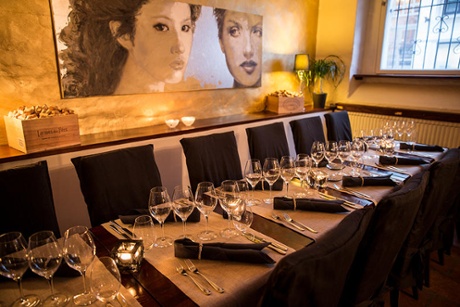
Somm restaurant
I’ve witnessed a lot of changes in the food scene in Gothenburg. There’s a far more professional atmosphere in the restaurants than there was before. The ingredients are better, and the customers are more aware of what they’re eating.
I moved from Småland to Gothenburg for college – and to become a chef. It was a way for me to move away from the small town I grew up in. I’ve now been working as a chef and head chef for 19 years, with stints everywhere from casual lunch places to one of the city’s Michelin-starred restaurants.
Today, a fairly ordinary restaurant in Gothenburg has the same quality of food that a fine-dining restaurant had 15 years ago. The thing that makes the city’s food scene special is the abundance of fresh fish and seafood, caught off the west coast. Some of the best places, such as Sjömagasinet (Adolf Edelsvärds gata 5), the Michelin-starred restaurant, where I have worked, puts its entire focus on seafood. But restaurants here also use a lot of organic meat and vegetables such as wild boar, new potatoes and freshly picked mushrooms.
A big trend in Swedish cooking now is that, instead of using just the nice cuts of meat, like the tenderloin, you use the whole animal – just as they did in times gone by. Somm (mains from 190SEK, about £14, Lorensbergsgatan 8) is great for this, and one of the chefs there is part of West of Sweden Culinary Team , which promotes local, organic ingredients. Swedes also have a really big interest in beer, and there are lots of microbreweries popping up around Gothenburg, including Dugges Ale och Porterbryggeri and Oceanbryggeriet.
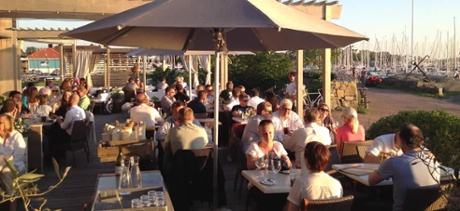
Långedrags Värdshus
Visitors should try a “half special” (halv special in Swedish). It’s a hotdog loaded up with mashed potatoes and a lovely shrimp-and-mayo salad. My personal favourite place to eat is Ölrepubliken (mains from about £11), Kronhusgatan 2B) – for the atmosphere, the wonderful beer, and the reasonably priced food, from mussels to steak tartare. Långedrags Värdshus (mains from about £17, Talattagatan 24) is a beautifully situated restaurant five miles to the west of the centre, right by the sea, with good food and a mix of young families and businesspeople. Upper House (six courses from about £92, Mässans gata 24) is a bit more expensive but has a great view over Gothenburg, along with some of the best-quality food you can get in this part of Sweden right now – there are six-course menus featuring everything from fresh langoustines to fermented raspberries.
When it comes to coffee and cakes, try the wonderful old courtyard of Kronhusbodarna (Kronhusgatan 1D), in the one of the city’s most historic areas. It’s a good place for a traditional Swedish fika (essentially a chat over coffee with friends, and perhaps a slice of cake) in an old, cosy atmosphere. Another favourite of mine is Brogyllen (Västra Hamngatan 2), a regular fika place (coffee and a cake around £4) with some of the best sourdough cinnamon rolls you’ll find anywhere on Earth.
Where to go for art and design
By Annie Granath, designer and interior architect
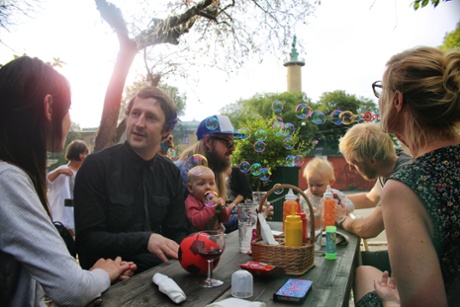
Friends gather at Oceanen bar. Photograph: Souvid Datta for the Guardian
The design scene in Gothenburg is small compared with Stockholm. There aren’t masses of cool design studios and most designers know each other. The upside of this is that things are more relaxed and people tend to help each other out more. Gothenburg is also home to one of Sweden’s most renowned craft and design schools, HDK. When something interesting involving design or craft takes place in the city, HDK has usually made a contribution in some way. Röhsska Museet is the best design museum in Sweden. Every year it holds an exhibition featuring the winner of the Torsten and Wanja Söderberg Prize, the biggest design award in the world. It also has a big collection of craft and design objects and some iconic furniture.
A recent addition is A-venue, a gallery opened by the University of Gothenburg on the city’s main street, Kungsportsavenyn. So far it has had one exhibition – of furniture, called DeTour HDK – that had been shown during design week in Milan. A-venue is set to be a great place to see new and interesting art and design.
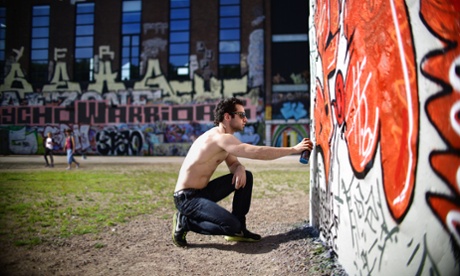
Gothenburg’s most prominent graffiti artist Sarai, works on a new mural by the R da Sten Konsthall beside Älvsborg suspension bridge. Photograph: Souvid Datta for the Guardian
For small galleries, Vasa is the part of town to head for. Here you’ll find places such as contemporary Galleri Thomassen and Göteborgs Konsthall. Röda Sten Konsthall is also worth a visit, among other things for its great location beside the Älvsborg suspension bridge.
For shopping, Artilleriet on Magasinsgatan has a great selection of furniture and some beautiful objects. It recently opened a new store called The Kitchen that’s full of cooking gadgets. Over Christmas, there are usually a lot of small markets and pop-up stores full of local crafts.
A perfect day for me would be to take the boat to one of the islands in the southern archipelago (Styrsö, for example). After that, I’d check out a photo exhibition at the Hasselblad Center, then enjoy the sunset from Masthuggskyrkan, where there’s a striking church, and have a beer at nearby Oceanen on Stigbergstorget.
Readers’ tips and Instagram
There’s no better guide to a city than word-of-mouth recommendations – from people who live there and people who have visited. We asked our readers to share their favourite experiences and Instagram pictures of Gothenburg . Here are just a few – you’ll find more here.
Askimsbadet beach
To escape the hustle and bustle of the bars and clubs of Gothenburg, try a short journey south (less than an hour) to a beautiful beach at Askimsbadet, with its own official surf clubhouse as well.
goteborg.com
neilmccartney
Canal tour
The canals evoke a Scandinavian Amsterdam, softened by steamy cafes that could almost be in Vienna. Only when you tuck into wintry-white seafood, served by statuesque blondes, do you remember you’re in Sweden. Try a Paddan canal boat tour, which sweeps under 20 bridges, including Osthyvel, the “cheese-slicer” bridge, which is so low you have to lie flat to pass underneath it. In winter, rugs are provided, along with gingerbread biscuits and steaming glögg – hot mulled wine.
stromma.se
LisaGerardSharp
Marstrand

Fjord with sailing boat close to Marstrand Photograph: Hans Georg Eiben/Getty Images/LOOK
An island north of Gothenburg, Marstrand is reached by bus or tour boats. The island has somewhat of a snobby reputation due to it being the centre of the sailing world in West Sweden, but it has good restaurants, cafes and boutique shops, and is a great place to walk or swim. Marstrand is also a must for discerning Abba fans, as the video for Winner Takes It All was filmed there.
marstrand.se
David Perrin
Free Ferries
If you get a one-day or three-day ticket for Gothenburg’s public transport, you can do a tour on the ferry for free. Hop on and hop off as many times as you like or just stay on the ferry all the way through. On a sunny day, it’s a summer must-do!
vasttrafik.se
Sonja Irani
This article originally appeared on guardian.co.uk
This article was from The Guardian and was legally licensed through the NewsCred publisher network.
![]()
